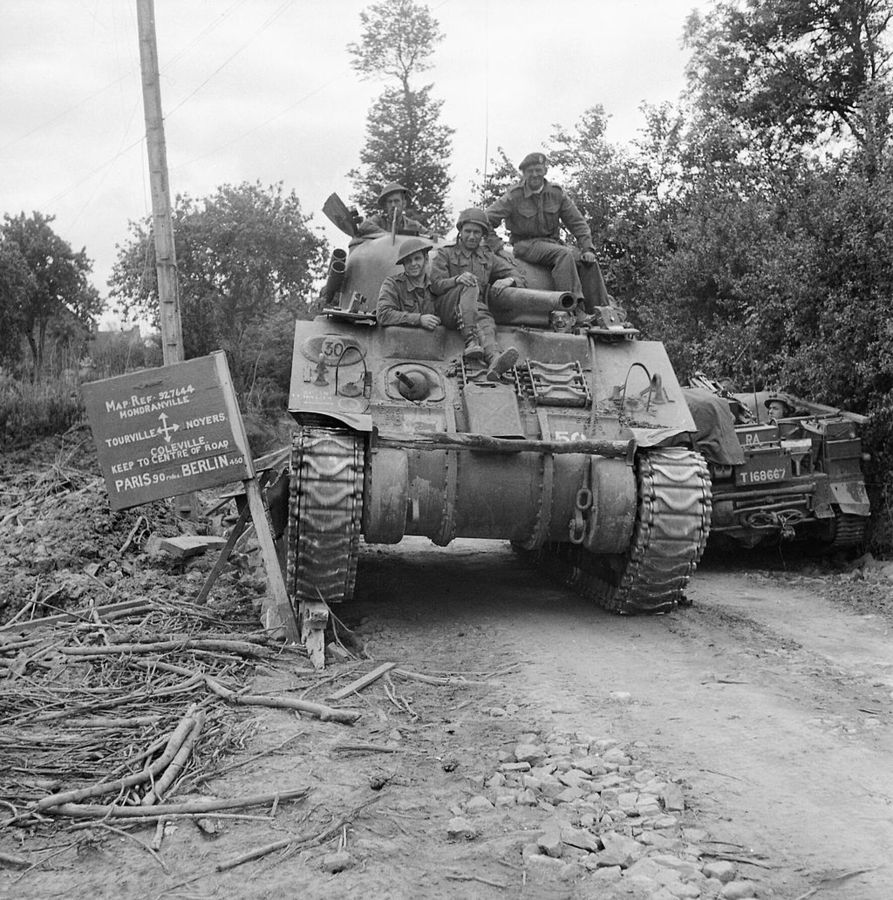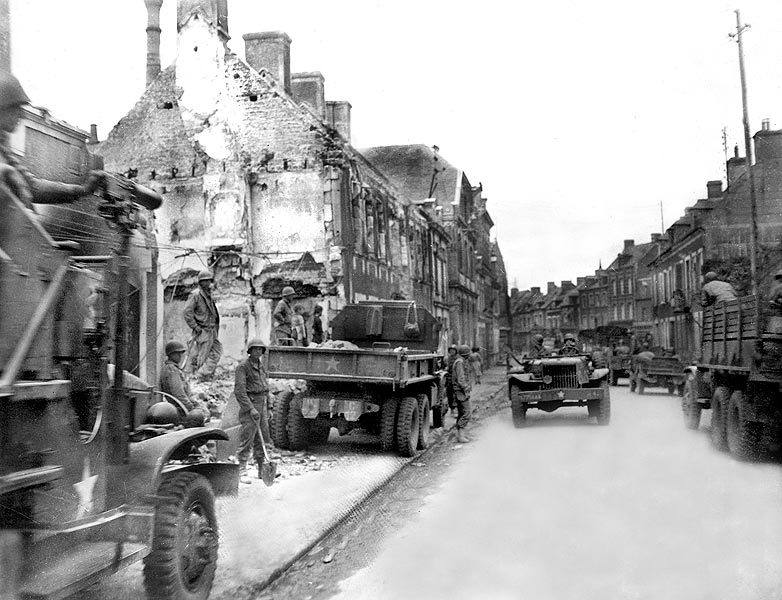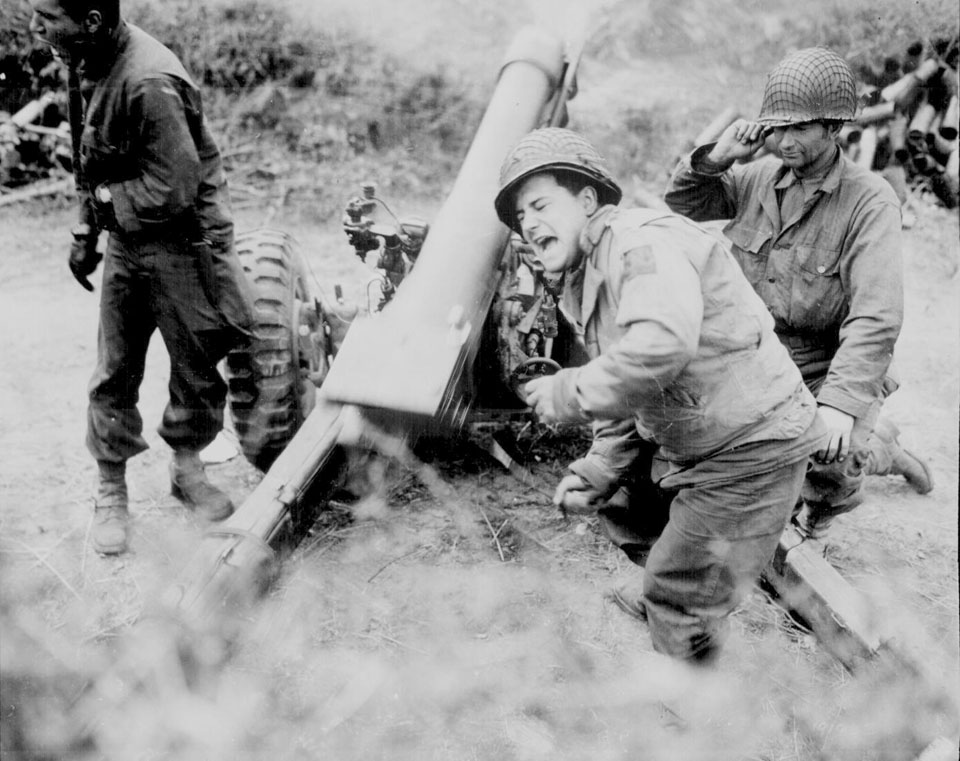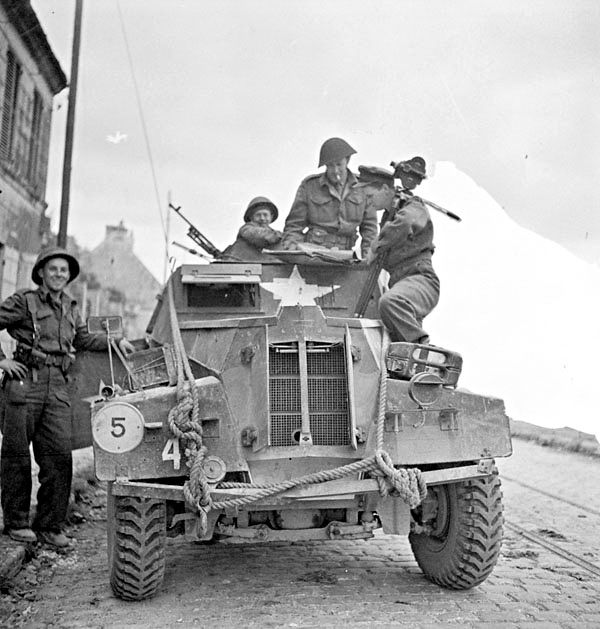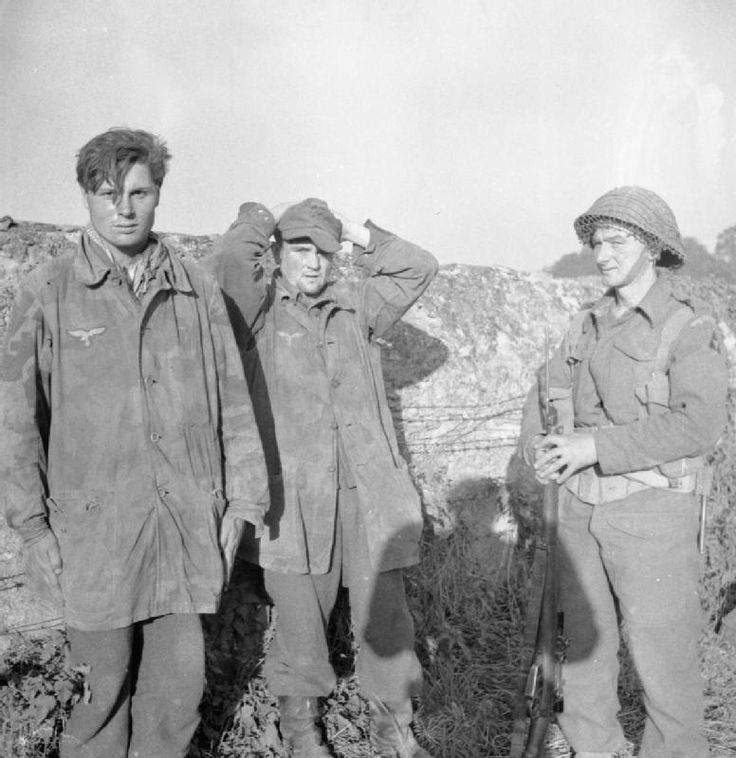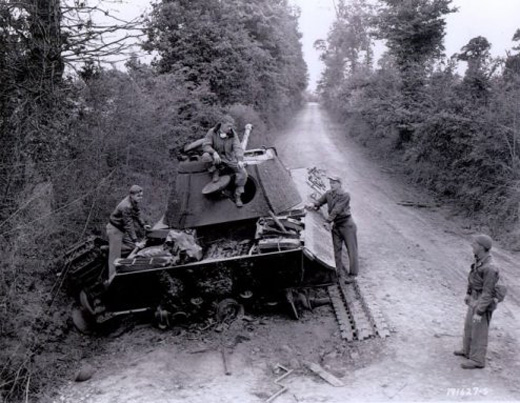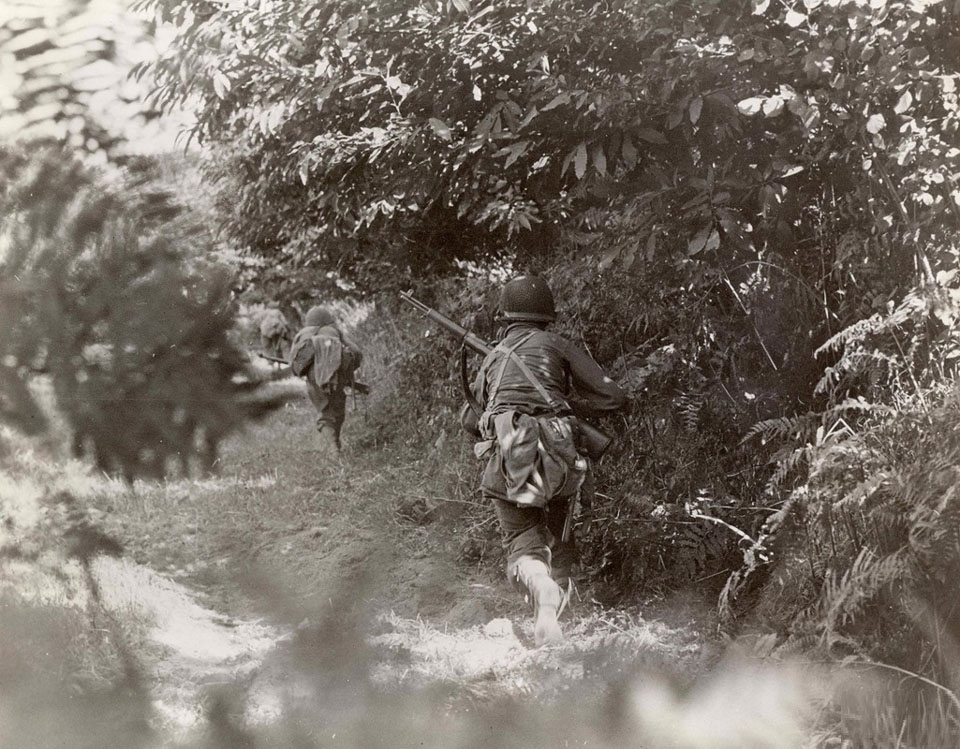Air Operations, Europe
RAF BOMBER COMMANDDaylight Ops:
- 26 Lancasters and 6 Mosquitos of No. 8 Group make 2 separate raids on a flying bomb site at Gapennes. The Lancasters make the first 'heavy Oboe' attack of the war. A Lancaster of No. 582 Squadron had been fitted with Oboe equipment and Wing Commander G. F. Grant, from No. 109 Squadron, one of the Oboe Mosquito squadrons, flies in the Lancaster and directs the bombing. When Grant releases his bombs, other Lancasters flying in formation do the same. This method allows a greater tonnage of bombs to be dropped directly on the Oboe signals and it becomes one of Bomber Command's most accurate bombing methods and enables small targets like the flying bomb sites to be bombed accurately in cloudy conditions.
- No aircraft are lost on this raid.
- 2 Mosquitos fly Ranger patrols and 1 attacks a tanker with cannon fire.
- There are no losses.
- 8 Mosquitos are sent to the Homberg oil plant, 21 aircraft are on Resistance operations and there are 3 Serrate patrols.
- There are no losses.
GERMANY:
- Guided by H2X radar, 1,047 8th Air Force B-17s and B-24s, escorted by 699 VIII Fighter Command fighters, attack marshalling yards, industrial targets, an airdrome, and several targets of opportunity in and around Munich.
- 16 B-24s, 4 B-17s, and 4 escort fighters are lost
FRANCE:
- IX Bomber Command B-26s and A-20s attack V-weapons sites, fuel dumps, and a rail bridge.
- 9th Air Force fighters and fighter-bombers escort the bombers and attack rail targets, fuel dumps, gun emplacements, and various targets of opportunity around the battle area in France.
ITALY:
- Despite bad weather, a number of 12th Air Force medium bombers are able to mount attacks against several rail targets and bridges.
- XII TAC fighter-bombers attack fuel dumps, gun emplacements, rail lines, the Rimini Airdrome, and targets of opportunity in the battle area.
FRANCE:
- When bad weather prevents missions from going to other areas, 87 15th Air Force B-24s attack the port area at Toulon.
Battle of the Atlantic
Sunderland 'P' of No 201 Squadron is flying a rectangular search pattern when the snorkel of a U-boat is spotted. As the aircraft came in U-1222 dives. 5 depth charges are released which fall a straddle around the stern. When the explosions subside, a large amount of wreckage is seen on the surface.
| Class | Type IXC/40 |
| CO | Kapitänleutnant Hans Bielefield |
| Location | Bay of Biscay, W of La Rochelle |
| Cause | Air attack |
| Casualties | 56 |
| Survivors | None |
CBI
CHINAIn central east China the Japanese 11th Army renews the attack against Hengyang but is repulsed by the Chinese with effective air support.
[Diplomatic Relations
Roosevelt announces that the US will recognize de Gaulle's French Provisional Government as the de facto authority for the civil administration of the liberated territory in France.
[Eastern Front
2nd Baltic Front (Gen Andrei Yeremenko) starts a new program of attacks on a 90-mile front east of Idritsa. Red Army units cross into Latvia and penetrate 40 miles into Lithuania. Elsewhere the German pocket, the German 4th Army?, east of Minsk is wiped out. 70,000 Germans have been killed since late June and 35,000 more taken prisoner.
SOUTHERN SECTORThe 1st Ukrainian Front is poised to open its offensive against Army Group North Ukraine. For the offensive, Koniev's 1st Ukrainian Front has 840,000 men with 14,000 arty pieces and 1,600 tanks among the 3rd Guards Army north of Lutsk, 13th Army between Lutsk and Brody, 60th, 38th, 1st Guards Armies massed between Brody and Tarnopol, 5th Guards Army behind the left wing of the 1st Guards Army and 18th Army on the southern wing at Kolomya. The 1st Ukrainian Front's armored forces, held in the second echelon, consists of the 1st Guards Tank Army near Lutsk, 3rd Guards Tank Army near Brody and 4th Tank Army near Tarnopol. 2 cavalry mechainzed groups, held north and south of Dubno, also provide support. The 2nd and 8th Air Armies are also attached and have 2,800 aircraft.
Also facing the northern wing of Army Group North Ukraine is the left wing of the 1st Belorussian Front. This force comprises the 70th, 47th, 8th Guards and 69th Armies concentrated north of Kovel with the 1st Polish Army and 2nd Tank Army in reserve.
Army Group North Ukraine, commanded by Gen Harpe in the absence of Field Marshal Model, has the 4th Panzer, 1st Panzer and 1st Hungarian Armies. The German forces deploy 34 infantry divisions, 5 panzer divisions and 1 panzer grenadier division, a total of nearly 500,000 men with 900 panzers, 6,000 arty pieces and 700 aircraft.
[Italy
Orders are issued for Operation MALLORY MAJOR, the destruction of bridges over the Po River. The American IV Corps makes limited progress northwards. In the British XIII Corps sector the New Zealand 2nd Div gets ready to support the final attack on Arezzo.[ITALY]
[New Guinea
<On Numfoor, TF CYCLONE (the US 158th Infantry and 503rd Parachute Regiments) begin the systematic mopping up of the island, the 158th Infantry in the north and the 503rd Paratroopers in the south. The 2nd Battalion of the 503rd arrives, having moved by air from Hollandia to Biak and from there by sea to the Namber airfield.
In the Aitape sector, the PERSECUTION Covering Force begins a general withdrawal from the Driniumor River line to the next delaying positions, along the line of X-ray River and Kornoal Creek, after a futile attempt to reopen the Anamo-Afua trail. Gen Walter Krueger orders that the line should be recaptured as quickly as possible. Meanwhile the 6,000 Japanese advancing west of the Driniumor come under constant attacks from Australian and US aircraft.
On Biak, the 3rd Battalion of the 163rd Infantry begins steadily compressing the Japanese in the Ibdi Pocket.
[Pacific
The US submarine Sealion (SS-315) sinks the Japanese merchant cargo ships No.2 Taiun Maru and No.2 Tsukushi Mar in the Yellow Sea of the west coast of Korea near Shosei Jima.
[United States, Politics
President Roosevelt tells a Press Conference that he will run if nominated. He says, 'If the people command me to continue in office...I have as little right as a soldier to leave his position in the line.'
[Western Front
The US 1st Army's offensive is now being carried out by all 4 corps at once, the VIII, VII, XIX, and V, deployed on a front from the west coast of the Cotentin peninsula to Caumont, about 13 miles east of St Lô.
While the units of the VIII Corps make considerable progress south of La Haye-du-Puits, a counterattack by the German Panzer Lehr Div succeeds in breaking through the lines of the 9th Div in the Le-Désert sector southwest of St Jean de Daye. A combined infantry and artillery action, with air support, drives the Germans back with the loss of a number of tanks.
The XIX Corps opens its offensive against St Lô with its 30th Div west of the Vire River and the 35th and 29th Divs on the east. The units in the V Corps renew their attacks in the direction of Height 192, northeast of St Lô.[WF]
In the British sector, the 50th Div of XXX Corps improves its positions near Hottot-les-Bagues, some 13 miles west of Caen. Meanwhile the British 43rd Div of VIII Corps takes the important Hill 112, southwest of Caen. The British around Caen are again supported by heavy naval gunfire.
[Images from July 11, 1944
|
|
|
|
|
|
|
|
